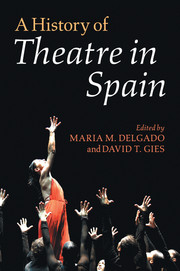Book contents
- Frontmatter
- Contents
- Illustrations
- Contributors
- Acknowledgements
- Introduction
- 1 The challenges of historiography
- 2 Lope de Vega, Calderón de la Barca and Tirso de Molina
- 3 The world as a stage
- 4 Playing the palace
- 5 The art of the actor, 1565–1833
- 6 Theatrical infrastructures, dramatic production and performance, 1700–1759
- 7 Popular theatre and the Spanish stage, 1737–1798
- 8 Theatre of the elites, neoclassicism and the Enlightenment, 1750–1808
- 9 Actors and agency in the modern era, 1801–2010
- 10 Zarzuela
- 11 Nineteenth-century Spanish theatre
- 12 Copyright, buildings, spaces and the nineteenth-century stage
- 13 Modernism and the avant-garde in fin-de-siècle Barcelona and Madrid
- 14 Continuity and innovation in Spanish theatre, 1900–1936
- 15 Theatrical activities during the Spanish Civil War, 1936–1939
- 16 Theatre, colonialism, exile and the Americas
- 17 Theatre under Franco (1939–1975)
- 18 Flamenco
- 19 Nationalism, identity and the theatre across the Spanish state in the democratic era, 1975–2010
- 20 Directors and the Spanish stage, 1823–2010
- 21 This evolution is still ongoing
- 22 Theatre as a process of discovery
- 23 Theatre is the art of the future
- Select bibliography
- Index
- References
8 - Theatre of the elites, neoclassicism and the Enlightenment, 1750–1808
Published online by Cambridge University Press: 05 June 2012
- Frontmatter
- Contents
- Illustrations
- Contributors
- Acknowledgements
- Introduction
- 1 The challenges of historiography
- 2 Lope de Vega, Calderón de la Barca and Tirso de Molina
- 3 The world as a stage
- 4 Playing the palace
- 5 The art of the actor, 1565–1833
- 6 Theatrical infrastructures, dramatic production and performance, 1700–1759
- 7 Popular theatre and the Spanish stage, 1737–1798
- 8 Theatre of the elites, neoclassicism and the Enlightenment, 1750–1808
- 9 Actors and agency in the modern era, 1801–2010
- 10 Zarzuela
- 11 Nineteenth-century Spanish theatre
- 12 Copyright, buildings, spaces and the nineteenth-century stage
- 13 Modernism and the avant-garde in fin-de-siècle Barcelona and Madrid
- 14 Continuity and innovation in Spanish theatre, 1900–1936
- 15 Theatrical activities during the Spanish Civil War, 1936–1939
- 16 Theatre, colonialism, exile and the Americas
- 17 Theatre under Franco (1939–1975)
- 18 Flamenco
- 19 Nationalism, identity and the theatre across the Spanish state in the democratic era, 1975–2010
- 20 Directors and the Spanish stage, 1823–2010
- 21 This evolution is still ongoing
- 22 Theatre as a process of discovery
- 23 Theatre is the art of the future
- Select bibliography
- Index
- References
Summary
Previous chapters have called attention to the preferences of the majority of the theatre-going public and the genres they found most attractive. Thanks to the reports that bookkeepers of local theatre companies completed after each performance, it is possible to know with relative precision not only the daily admission fees but also the number of spectators who bought tickets, and where they sat (or stood). Generally, a spectator's location in the theatre corresponded to his or her financial means as well as gender, given that the majority of women – many of whom sat with their husbands or families in the three floors of boxed seating or aposentos that were rented as a whole – reserved the wide, slightly elevated gallery or cazuela (women's gallery) found at the back of the coliseum's patio. These points are helpful in tracing the itinerary of a particular work and in attempting to understand better what type of audience enjoyed it; information that helps us to modify the opinion of chroniclers and journalists.
The capacity of the two major playhouses, the Coliseo (Teatro) de la Cruz and Coliseo (Teatro) del Príncipe, can be estimated at slightly less than 2,000 spectators each. The often unruly commoners, who were the most imposing and most tightly packed group in the audience, filled the patio and the bleachers. There were around 1,000 individuals who attended the show, many of them standing or even on tiptoe, with the obvious inconveniences exacerbated by a constantly yet dimly lit room with acoustics that were far from perfect. The cazuela in the Cruz held approximately 350 women, while the Príncipe accommodated 450. Painter Luis Paret y Alcázar's preparatory drawing for the Baile en máscaras (Masquerade Ball, 1767) indicates that, to the right of the Príncipe's gallery, there were two open doors that led to the men's and women's toilets, separated by a narrow corridor. The theatre reformers, then, aspired to ‘enseñar deleitando’ (teach by pleasing) and to enlighten the motley, and rather unstable, crowd by means of tragedies and comedies in the neoclassical style.
- Type
- Chapter
- Information
- A History of Theatre in Spain , pp. 157 - 172Publisher: Cambridge University PressPrint publication year: 2012

